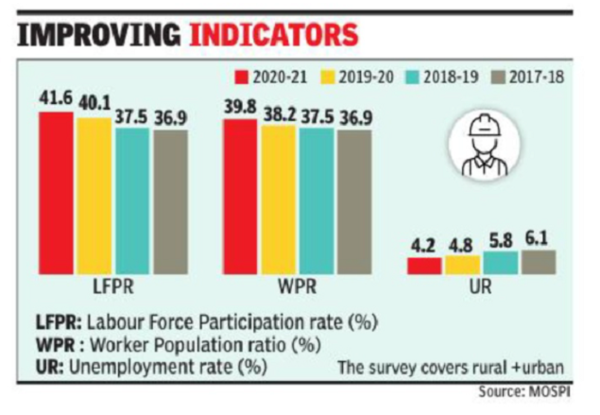By Dr. Gyan Pathak
After years of criticism, PM Narendra Modi led Government has finally released its first ever monthly Periodic Labour Force Survey (PLFS) on May 15, 2025 for the month of April 2025, as per the revamped PLFS. Though it saved the government from the allegation of not producing timely data on labour, its data on the revamped PLFS still do not show the real picture of unemployment in India, as it exists on the ground. The difference can be seen in the fact that revamped PLFS shows unemployment rate at 5.1 per cent in April 2025(a rise from 4.9 per cent in 2024 under Old PLFS), while the Centre for Monitoring Indian Economy (CMIE) data found it at 7.73 per cent. Why such a great difference? And which data is more reliable?
Before going into details on the first ever monthly PLFS report, it should be recalled that at a time when unemployment was breaking records of decades in India, Modi government had changed the earlier system of Labour Surveys and launched a new system called PLFS in 2017. Nevertheless, even under PLFS, it was found that unemployment had reached 45 years high at 6.1 per cent in 2018. Under the PLFS, two sets of data in released – Usual Status data and Current Weekly Status (CWS) data, former on yearly basis, and the later on weekly basis.
Usual Status data have been always lower and CWS data always higher, which confused the common people. For example, unemployment rate in 2024 on usual status basis was 3.2 per cent, which was only a minor rise from 3.1 per cent. However, under CWS the unemployment rate declined marginally from 5 per cent in 2023 to 4.9 per cent in 2024. It exposed the error in the data, which were contradictory in the first place – one showed rise and the other showed decline. Data under PLFS was clearly of low quality, even if we accept the government headcounts, which left many unemployed uncounted, and many not paid households help as employed. Many own account workers were actually unemployment under disguise and many earning too low to survive with human dignity. PLFS also counted those as employed who got at least 1 hr of work in a week.
The dissemination of labour data was much delayed. Employment and unemployment data for rural areas were available only yearly – from July to June – that too after a delay of several months. From December 2018, government launched quarterly PLFS data for urban areas, but reports used to be released after months of delay. Now by beginning monthly data on employment and unemployment to be released every month after a delay of about a fortnight, for both rural and urban areas, the government has saved itself from the allegation of not releasing labour data on realtime basis.
Nevertheless, the labour data quality will remain a serious concern, in the light of the changes made in PLFS 2025. The document “PLFS: Changes in 2025”says, “Considering the need for generation of high frequency labour force indicators at a further disaggregated level the sampling methodology of PLFS has been revamped from January 2025.”
It is the second time the government has changed the methodology of PLFS since 2017. Unemployment has undergone an unprecedented rise in the meantime, while PLFS methodology and data produced were not even believed by the Union Ministry of Labour and Employment or even the Prime Minister PM Narendra Modi of India, or why else they preferred not to mention their own data, but opted to quoted KLEMS database of the Reserve Bank of India, to claim that 17.19 crore jobs were created between 2014-15 and 2023-24, just during the Lok Sabha Election 2024?
It worked about 2 crore jobs per year, that was promised by Narendra Modi during indirectly when he said to provide “work for every hand” that was interpreted as 2 crore, since that much people enter every year into the workforce in India. It was part of PM Modi’s strategy to quote RBI data, for which he and his government could not be made responsible, because the data was not theirs.
One can clearly see the RBI’s puzzling KLEMS data to be false, which showed increase in employment in the year of demonetization in 2016-17 to 47.3 crore from 47.1 crore in 2014-15, while millions of MSMEs were either shut down or significantly scaled down production due to cash crunch, rendering millions of job loss in the country. Then again when the entire economy was shut down and put under COVID-19 containment measures, it showed employment rose to 56.6 crore in 2020-21, and when COVID-19 worsened in 2021-22, it showed further rise of employment to 57.8 crore. For 2022-23, it showed number of employed rose to 59.9 crore and for 2023-24 to 64.3 crore. More surprising that the data showed rise in employment even when GDP became a negative (-)5.8 per cent in 2020-21.
Nobody believed PM Modi’s claim during the Lok Sabha election 2024 campaign, which resulted in great loss in number of BJP’s seats which reduced to 240, bringing his party to minority. Unemployment in general, and among the youth remains an issue in the country, and people still do not believe the government.
Can PM Narendra Modi led government save its face with the revamped PLFS data? It is most unlikely, since the new methodology for headcounts of employed and unemployed is not acceptable for the common people. New methodology has not corrected the earlier debatable headcount methods, but has adopted new ones – such as rotational schemes for PLFS, rotational panel design, change in outline of the design, stratification of First Stage Units (FSUs) and then their sub-stratification and so on, which people need to understand afresh to know their impact on the data quality.
Nevertheless, the data released for April 2025 on revamped PLFS, shows that unemployment rate in CWS for 15 years and above was 5.1 per cent, much below the CMIE data of 7.73 per cent. PLFS data showed unemployment in the rural areas at 4.5 per cent and in urban areas 6.5 per cent. Female unemployment rate in urban areas was 8.7 per cent while male unemployment was 5.8 per cent. As for rural area, female unemployment was 3.9 per cent and male unemployment was 4.9 per cent. Unemployment rate among youth between 15-29 years was as high as 13.8 per cent, which is a matter of great concern.
Labour Force Participation Rate (LFPR) in CWS in April 2025 was 55.6 per cent, for rural areas 58 per cent and for urban areas 50.7 per cent. It should be a matter for great concern that female LFPR in urban areas is just 25.7 per cent, and rural areas 38.2 per cent, which shows that the current policies for empowerment of women are not working. Another matter of concern is the LFPR for youth (15-29) years which is just 42.7 per cent.
Worker Population Ratio (WPR) also shows distressing picture. WPR in CWS was 52.8 per cent, 55.4 per cent in rural and 47.4 per cent in urban areas. Female WPR in urban areas was just 23.5 per cent while it was 36.8 per cent in rural areas. For youth (15-29 years) it was just 36.8 per cent.
The figures on the basis of revamped PLFS shows dismal labour scenario in India, which youth and females are most suffering lots, though PM Modi has been claiming doing much for youth and women empowerment.
The report will take time to be fully understood, since the revamped PLFS is churning out a data that is not comparable with the earlier data of PLFS. The report itself warns, “The results of the PLFS post January 2025 thus need to be understood and used in the context with which the sample selection methodology of PLFS has been designed.” (IPA Service)




 Centre Has To Take Proper Lessons From Latest Data On Covid 19 Deaths
Centre Has To Take Proper Lessons From Latest Data On Covid 19 Deaths 